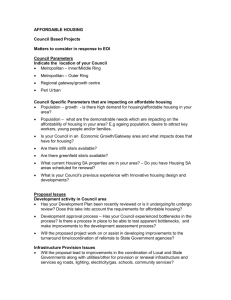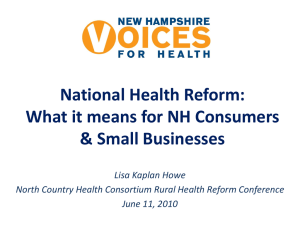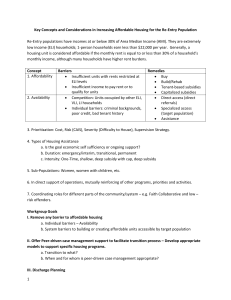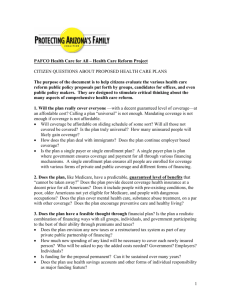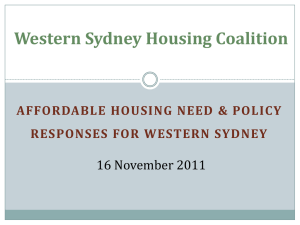NAHC Influencing Housing Strategy
advertisement
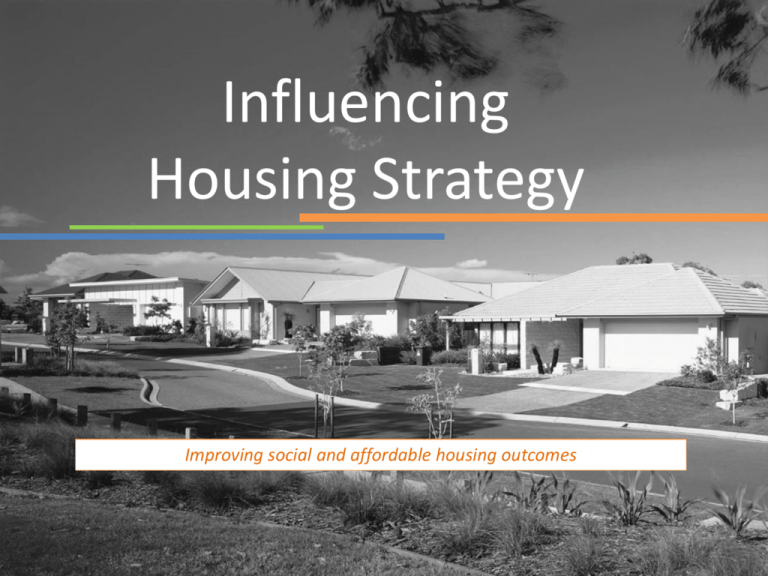
Influencing Housing Strategy Improving social and affordable housing outcomes Macro Housing Policy Reform – Seeking Government, Industry and Community support to achieve the following 5 goals [See NAHC full submission to Senate Inquiry] Goal 1 Co-ordinate a generation of supply side action to address the current and projected supply shortages that are fuelling housing affordability problems. Goal 2 Align the range of financial levers, including negative gearing and tax concessions, towards clear long term housing policy objectives including new supply, affordability, diversity and appropriateness for changing demographic needs and meeting ‘whole of life’ utility. Goal 3 Reform and renew social housing to create a viable and more responsive and diverse system. This includes making better use of land and assets to stimulate new investment to grow and diversify social housing supply, better match housing portfolio to housing need and strengthening community housing outcomes Goal 4 Develop and support a new long term private rental market segment, funded and held by institutional investors and managed by Registered Providers that meets community need for affordable, secure and long term rental housing. Goal 5 Improve the pathways between social, affordable and market housing. Including through supporting innovations like Shared Equity Home Ownership, rent to buy, greater choice and mobility, self build and housing co-operatives NAHC Contribution to new housing directions Policy Research & Development Delivery Models With our partners:- influence long term housing and finance policy to achieve better housing outcomes for Australia With our partners:- contribute to the provision and application of a strong evidence base for improvements in policy, funding and delivery With our partners:- create a suite of viable and effective delivery models for social and affordable housing that meet diverse needs and use resources efficiently Promote the 5 policy goals and seek to influence decision makers across Government, Industry, Finance and Community sectors Sustainable Built Environment national research centre partnership: 1. Research into housing and non housing outcomes of social housing and social housing reform & establish a nationally consistent Evaluation Framework Our three NRAS delivery models are completed and are delivered or awaiting further tender decisions: NRAS- Market NRAS-Social & NRAS-Land Focus on opportunities to influence 1. Institutional Investment into affordable housing and the creation of a long term secure private rental market 2. NAHA Reform 3. Social Housing reform 4. Integrated approach to housing reform and economic & social development Bond University Partnership Other models developed and submitted under Tenders are 1. NON NRAS Affordable Housing with discounted rent guarantee 2. Shared Equity Home Ownership, acceptable to mainstream banks 3. Social Housing Renewal based on reconfiguring existing assets Participate in / seek to influence policy via multiple channels including: 1. Tax Review 2. New Federation White Paper 3. Direct engagement with Commonwealth and State Ministers 4. Input through the Senate Inquiry 5. Input into the Oppositions review of housing policy Other, including:1. NAHC Institutional Investment Committee research & development [ISPT,ISN,PCA + other experts] 2. Melbourne University and Carlton Connect. 3. NDIS Architectural Design Competition 4. New building methodologies and application 5. Synergy unit trust funding methodology 1. Bond University & NRAS Providers Ltd NRAS Stage 1& 2 Economic Reports 2. Bond University and others in the Academy for Affordable Housing Leadership Further work is continuing on 1. Finalising an NRAS based institutional model 2. NAHA Capital Grants Model 3. NDIS models 4. PPP in a Private Sector Led initiative A key focus is the ability of renewal to act as a catalyst within an economic development framework providing jobs and training Reform and renewal of social housing Public Housing has been declining as a proportion of the nations stock for 20 years and despite the much needed boost through the Social Housing Initiative the trend remains downward. Furthermore the portfolio is aging and requiring greater commitment of maintenance expenditure. Depending on the portfolio, it may be mismatched to the growing demand for 1 and 2 bed dwellings and dwellings that are fully disability accessible. The current income stream from public housing is inadequate to meet its expenses and this lack of viability leads to further decline in stock. The cost of providing services to those in very high needs cannot be met from inadequate rental income. The gap between the social housing system and the market is now so great that it is a disincentive to tenants to consider moving. Community support is also eroding and this leads to political marginalisation. Grow, renew and diversify social and affordable housing Establish a long term financially viable model, including meeting operational deficits, making better use of assets and attracting third party resourcing Better match housing to changing needs Provide a ‘Human Services’ model of supporting those in need, but acknowledge the strengths and resilience of individuals and communities and build on these strengths through better participative arrangements. A strength-based approach needs to encompass economic and social development Provide more pathways between social, affordable and market housing and more diversity in provision Genuine reform cannot simply be based on a ‘Grab ‘for Commonwealth Rent Assistance, nor can it just involve a change of the managerial system from the State to Not For Profits. Principles for a new Partnership between States and NFP Housing Providers Outcome based funding and partnership arrangements Open and innovative and avoiding prescription and micro management Mutuality between NFP and Government with inter-dependencies recognised in contract framework Mutual interests of all parties aligned to achieve outcomes A sound and proportional regulatory framework based on NRS which oversights risk and performance Respectful of independent charitable and corporate governance requirements Understanding the range of Accountabilities An incentive based approach A learning culture and adjustment process Open culture and honest appraisal NDIS & NDIA How the NDIA can increase housing supply options 1.A flexible approach to ‘reasonable and necessary’ support arrangements 2.Using the ‘cost of capital’ built into Scheme costs as a catalyst for major growth in affordable and accessible housing 3.Building on recent housing sector reforms, e.g. NRAS, social finance development 4.Influencing the National Disability Strategy and the housing sector, as part of being a catalyst for wider social change and inclusion This provides the NDIA with funding estimated at around $550m per annum in scheme costs for the ‘user cost of capital’ at full scheme (in today’s dollars) Funding is included during launch, gradually increasing to $700m per annum (2018/19 dollars) when there is full national rollout in 2019 This is a large amount but to achieve maximum impact it must act as a catalyst and be leveraged two to three times, as well as being available to be recycled, as new participants join. Reconnecting the social housing system and the market Providing a diverse range of affordable housing options to provide pathways and choices The gap between the social housing safety net and the general market is too great for many tenants to bridge without some intervening steps that provide more alternatives. Mobility and through-put is undermined by a lack of pathways towards the market. This closes off opportunities for those needing social housing as stock turn-over declines. The subsidy model is too rigid and unsophisticated creating further barriers to progressing beyond social housing Alternatives, like shared equity home ownership and ‘rent to buy’ can help reinstate an effective pathway and support for self-build, shared housing and equity co-operatives can help ease the pressure on the social housing system. Building new social housing, for those in greatest need, also grows the housing cake, and allows new stock to be provided in areas where the demand is greatest and provision is currently lacking Can’t we provide more choice? We can provide other colours too Its always been blue, that’s the only colour I have Diverse forms of social and affordable housing to increase supply and make better use of subsidy Three Social Housing Objectives 1.Better Services: 2. Renewed & Better Matched Housing: Renewal is governed by two key factors: The sale of assets to finance reconfiguration and upgrade, and improved land use to provide the right size/type of new homes Existing Stock Assessed & Renewed = No Loss of numbers / Better Matched Additional social & affordable properties Improved Property & Tenancy Management 3. Viability and Growth New ‘additional properties are financed by NAHC and its partners. Affordable housing is owned privately and additional social housing is owned by NAHC and its partners A Human Services approach is adopted and ‘Personal Housing Plans’ introduced. CRA revenue re-invested in service improvements and asset renewal Attracting and protecting investment in social and affordable housing Where does the additional money come from ? $ - Eligible tenants will receive Commonwealth Rent Assistance and pay it in their rent to NAHC. CRA is on average around $55pw. So 1,000 social housing tenancies would generate an additional $2.75m per year. [As part of a full rent roll of around $9m per year] $ - Eligible charitable activities will receive GST and other Tax Concessions $ - NAHC and its partners can contribute equity to grow the system or borrow money to invest in new housing $ - NRAS and other government [NAHA / NDIS] and non government funding streams are open to NAHC and these can be packaged to meet community need. This can include private investment in affordable housing $ - If housing can be renewed, savings in maintenance can be re-applied to new capital investment. Typical social housing costs on older dwellings may be $3,000 py where the cost and sinking fund for new dwellings would be $1,200. A saving of $1.8m each year on each 1,000 dwellings $ - If public housing is ‘mismatched’ to need, a sales program can release funds to be re-applied to building more and better matched housing $ - unused Government land can act as an incentive to mixed tenure investment $ - private sales, like Shared Equity can balance economic and social returns and reduce long term dependency on subsidy 10 Steps to inform the reform & renewal choices faced by States 1. 2. Assess the economic and social performance of the social housing portfolio Identify the economic and social trends facing the portfolio [ aging stock, maintenance backlog, demand for smaller dwellings, demand for disability accessible dwellings, income profiles etc] 3. Assess the economic and social performance of the area and consider how housing reform will link to and influence economic and social development planning and implementation 4. Assess the market opportunity presented by renewal and land release for new building 5. Assess the growth in demand from those with high needs and assess how well the housing and support system cope with current need and plan for future needs 6. Assess the pathways into and beyond social housing and consider how a range of alternative affordable housing and market housing solutions can be provided to improve the pathway 7. Introduce a ‘strength-based’ approach to community and tenant participation and complement this through the development of individualised tailored-’Personal Housing Plans’ agreed with each tenant 8. Maximise the receipt of Commonwealth Rent Assistance for re-investment in improving housing outcomes 9. Maximise third party investment, including Charitable tax concessions, private investment and direct NFP equity or debt financed investment 10. Ensure a proper evaluation framework sits across the initiative capturing housing and non housing outcomes and individual and community outcomes against targets and against benchmarks Not ‘just’ vulnerable, also resilient! - A Strength Based Approach A Personal Housing Plan will reframe the relationship between tenants and the social housing system …. a future where a regional system co-ordinates housing and support resources and where each tenant has a Personal Housing Plan that builds on their strengths and aspirations, identifies barriers and sets pathways within and beyond social housing. It links in services through written agreements and provides a new ‘contract’ with tenants to enhance responsibility and provide clarity around service responses • . Alongside ‘personal housing plans’ for individuals, reform means a cultural and structural shift for social housing:Culture: Tenants are both Customers and Partners: Tenants, community and local business need to be involved in service planning and setting community priorities Structural: Social housing policy outcomes need a stronger connection to economic development to avoid a spiral of social exclusion. Renewal can also act as a catalyst for new investment. Improved service co-ordination: Better Housing & Non-Housing Outcomes …a future where tenants can enjoy improved access to the support they need and where housing and support is better co-ordinated. A future where homeless people and those transitioning from institutional care can have a planned approach to re-housing and where a staged and supported ‘resettlement’ is provided to maximise success Acting as a catalyst for more efficiency in multiple agencies engaged with the same ‘client’

